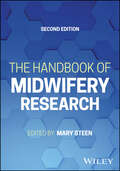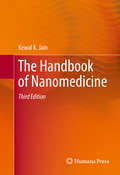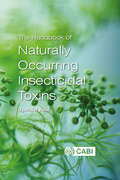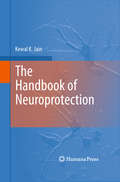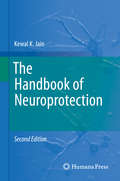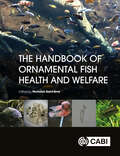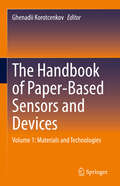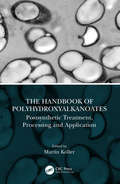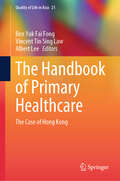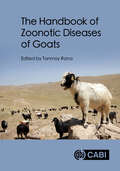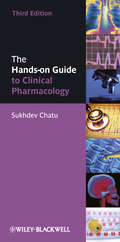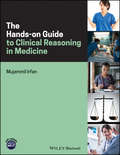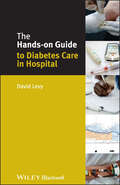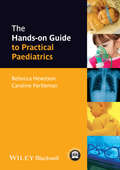- Table View
- List View
The Handbook of Midwifery Research
by Mary SteenAn accessible introduction to the spectrum of research in maternity care The Handbook of Midwifery Research, Second Edition, enables midwives and student midwives to search and make sense of research evidence, write research proposals, and undertake and disseminate research studies. Written in a concise and accessible style, this book includes useful tools and techniques to keep readers up to date with the best available evidence to apply to their own clinical practice. This second edition has been extensively revised to reflect current midwifery research and involves a range of study designs. The book is divided into three parts: understanding research, undertaking research, and publishing research. The Handbook of Midwifery Research includes information on: Different types of reviews and steps to assess them when little information is published on a topicHow to use a search strategy and search terms, including the PRISMA guidelines and flowcharts to show search stages systematicallyCritical analysis of reported research, and integrating results and findingsQuantitative and qualitative data collection methodologies, and mixed methods with specifics on convergent, sequential explanatory, exploratory, and hybrid study designsThe history and role of ethics in healthcare, midwifery, and research governanceThe importance of the links between research, education, policies, and clinical practice With case studies, learning objectives, and clear examples throughout, The Handbook of Midwifery Research is an essential learning resource for any midwife or student wanting to approach research with confidence.
The Handbook of Nanomedicine
by Kewal K. JainNanomedicine is clinical medicine with the application of nanobiotechnology, which is currently being used to research the pathomechanism of disease, refine molecular diagnostics, and aid in the discovery, development and delivery of drugs. In The Handbook of Nanomedicine, Prof. Kewal K. Jain distills the voluminous literature relevant to the subject into one concise, comprehensive and easy-to-use guide. Beginning with the basics, the subject is developed to potential clinical applications, many of which are still at an experimental stage. Important components of nanomedicine such as nanodiagnostics and nanopharmaceuticals are covered extensively. As this text is aimed at nonmedical scientists, pharmaceutical personnel, as well as physicians, descriptions of the technology involved and other medical terminology are kept as clear and simple as possible. In depth and cutting-edge, The Handbook of Nanomedicine informs its readers of the ever-growing field of nanomedicine, destined to play a significant role in the future of healthcare.
The Handbook of Naturally Occurring Insecticidal Toxins
by Opender KoulNaturally occurring toxins are among the most complicated and lethal in existence. Plant species, microorganisms and marine flora and fauna produce hundreds of toxic compounds for defense and to promote their chances of survival, and these can be isolated and appropriated for our own use. Many of these toxins have yet to be thoroughly described, despite being studied for years. Focusing on the natural toxins that are purely toxic to insects, this book contains over 500 chemical structures. It discusses the concepts and mechanisms involved in toxicity, bioassay procedures for evaluation, structure-activity relationships, and the potential for future commercialization of these compounds. A comprehensive review of the subject, this book forms an important source of information for researchers and students of crop protection, pest control, phytochemistry and those dealing in insect-plant interactions.
The Handbook of Neuroprotection
by Kewal K. JainNeuroprotection has been placed on a firm scientific basis during the past decade due to an improved understanding of the molecular basis of neurological diseases and the knowledge that treatment of neurological disorders should not be merely symptomatic but preventative against the progression of the underlying disease, as well as regenerative. The Handbook of Neuroprotection serves as a comprehensive review of neuroprotection based on knowledge of the molecular basis of neurological disorders. Neuroprotective effects of older, established drugs, as well as new drugs in development, are well documented in this detailed volume, featuring the most cutting-edge and innovative methods currently in use. In-depth and authoritative, The Handbook of Neuroprotection features a compendium of vital knowledge aimed at providing researchers with an essential reference for this key neurological area of study.
The Handbook of Neuroprotection
by Kewal K. JainThis fully revised edition explores the management of neurological disorders with a focus on neuroprotection, disease modification, and neuroregeneration rather than symptomatic treatment. Since the publication of the first edition, advances in biotechnology, particularly in cell and gene therapies, are reflected in this volume, as are numerous new and repurposed drugs in clinical trials. Overall, The Handbook of Neuroprotection serves as a comprehensive review of neuroprotection based on knowledge of the molecular basis of disorders of the central nervous system. In-depth and authoritative, The Handbook of Neuroprotection, Second Edition features a compendium of vital knowledge aimed at providing researchers with an essential reference for this key neurological area of study.
The Handbook of Ornamental Fish Health and Welfare
by Nicholas Saint-ErneThis book forms a complete resource covering ornamental fish health and welfare from a recognized expert on the topic. Beginning with an overview of the tropical fish industry and aquarium keeping, it covers all the key elements of care, including water-quality testing and maintenance, filtration systems, nutrition, husbandry, handling and transportation of fish, disease diagnosis, treatments and medications, and disease prevention. It also reviews areas of wider interest, such as biosecurity and zoonoses. The book can be read through to gain a complete overview of the care and welfare of ornamental aquarium and pond fish, or it can be used to easily look up specific information about a topic of interest. With numerous illustrations and photographs, plus references allowing readers to study areas of interest in more detail, this book makes an invaluable teaching and reference handbook. It is a vital source of information for veterinarians, scientists using fish in their labs, students, ornamental fish breeders, retail pet store workers, and aquarium keepers looking for trusted advice about how to properly care for their ornamental freshwater fish.
The Handbook of Paper-Based Sensors and Devices: Volume 1: Materials and Technologies
by Ghenadii KorotcenkovThis collection on materials and technologies is the first of a three-volume handbook on all aspects of paper-based devices from synthesis of nanocellulose and paper fabrication to discussion of features of fabrication of various flexible sensors and electronic devices on paper substrates. Subsequent volumes address sensors and bio- and environment engineering, electronics, and energy technologies. The books also present a comprehensive and detailed analysis of all aspects of applications of these sensors and devices in environment monitoring, biomedicine, healthcare, agriculture, the food industry, energy, electronics, optoelectronics, and other domains. Paper-based bioengineering and environment engineering are also discussed in detail in these books. The books enable the reader to understand the present status of paper-based sensors and devices and the role of paper in the development of new generation of sensors and electronic devices for various purposes with enhanced efficiency. World renowned experts with extensive expertise in the development of nanocellulose-based technology and paper-based sensors and electronic devices comprise the contributors to this collection. The Handbook of Paper-Based Sensors and Devices is an authoritative reference for materials scientists, biologists, physicians, and biochemical engineers as well as for chemical, biomedical, environmental, electronics, agriculture engineers and the food biotechnologists, working in R&D industry and academia. It further stands as a valuable teaching tool for university faculty and students working in chemical sensing, biosensing, biomedicine, biomaterials, environment protection and remediation. Illustrates the unique properties of paper and nanopaper make them adaptable for use in a wide range of applications; Considers in detail the synthesis/modification of nanocellulose intended for use in various fields; Analyzes the specifics of manufacturing paper-based flexible and wearable sensors and systems for various applications.
The Handbook of Patient Safety Compliance: A Practical Guide for Health Care Organizations
by Fay A. Rozovsky James R. Woods Jr. Maree BellamyWritten for virtually every professional and leader in the health care field, as well as students who are preparing for careers in health services delivery, this book presents a framework for developing a patient safety program, shows how best to examine events that do occur, and reveals how to ensure that appropriate corrective and preventative actions are reviewed for effectiveness.
The Handbook of Polyhydroxyalkanoates: Microbial Biosynthesis and Feedstocks
by Martin KollerThe first volume of the "Handbook of Polyhydroxyalkanoates (PHA): Microbial Biosynthesis and Feedstocks" focusses on feedstock aspects, enzymology, metabolism and genetic engineering of PHA biosynthesis. It addresses better understanding the mechanisms of PHA biosynthesis in scientific terms and profiting from this understanding in order to enhance PHA biosynthesis in bio-technological terms and in terms of PHA microstructure. It further discusses making PHA competitive for outperforming established petrol-based plastics on industrial scale and obstacles for market penetration of PHA. Aimed at professionals and graduate students in Polymer (plastic) industry, wastewater treatment plants, food industry, biodiesel industry, this book Covers the intracellular on-goings in PHA-accumulating bacteria Assesses diverse feedstocks to be used as carbon source for PHA production including current knowledge on PHA biosynthesis starting from inexpensive waste feedstocks Summarizes recent relevant results dealing with PHA production from various organic by-products Presents the key elements to understand and fine-tune the microstructure and sequence-controlled molecular architecture of PHA co-polyesters Discusses the use of CO-rich syngas, sourced from various organic waste materials, for PHA biosynthesis
The Handbook of Polyhydroxyalkanoates: Postsynthetic Treatment, Processing and Application
by Martin KollerThe third volume of the Handbook of Polyhydroxyalkanoates (PHA) focusses on the production of functionalized PHA bio-polyesters, the post-synthetic modification of PHA, processing and additive manufacturing of PHA, development and properties of PHA-based (bio)composites and blends, the market potential of PHA and follow-up materials, different bulk- and niche applications of PHA, and the fate and use of spent PHA items. Divided into fourteen chapters, it describes functionalized PHA and PHA modification, processing and their application including degradation of spent PHA-based products and fate of these bio-polyesters during compositing and other disposal strategies. Aimed at graduate students and professionals in Polymer science, chemical engineering and bioprocessing, it: Covers current state of the art in the development of chemically modifiable PHA including mult-istep modifications of isolated biopolyesters, short syntheses of monomer feedstocks and so forth. Describes design of functionalized PHA-based polymeric materials by chemical modification . Illustrates preparation of bioactive oligomers derived from microbial PHA and synthetic analogues of natural PHA oligomers. Discusses processing and thermomechanical properties of PHA. Reviews advantages of PHA against other bio-based and conventional polymers with current applications and potential uses of PHA-based polymers highlighting innovative products.
The Handbook of Primary Healthcare: The Case of Hong Kong (Quality of Life in Asia #21)
by Ben Yuk Fai Fong Vincent Tin Sing Law Albert LeeThis handbook adopts a transdisciplinary approach to primary healthcare, incorporating a wide scope of perspectives and case studies from Hong Kong in China. It consists of four sections that explore the foundations, practices, development aspects of primary healthcare and systems. The book also pays particular attention to the psychosocial and humanistic contexts of primary healthcare, exploring dimensions such as misinformation in the age of social media in health communication and aspects of resilience in primary healthcare. With contributions from scholars and practitioners in areas that include family medicine, psychology, nutrition, health policy, health education, dentistry, social work, as well as Chinese medicine, it is an expansive presentation of current knowledge on healthcare in the community setting. It is an indispensable reference for policymakers, researchers, advanced students, primary healthcare professionals, community health practitioners, and health managers and educators seeking to collate the practical and philosophical aspects of healthcare, in Hong Kong particularly, but also in Greater China and Asia more broadly. Beyond its relevance to the immediate medical community, it is also a valuable text for researchers in medical law, social sciences, quality of life studies, public policy, business administration, and information technology and health communication.
The Handbook of Psycholinguistic and Cognitive Processes: Perspectives in Communication Disorders (Routledge International Handbooks)
by Jackie Guendouzi Filip Loncke Mandy J. WilliamsThis handbook includes an overview of those areas of cognition and language processing that are relevant to the field of communication disorders, and provides examples of theoretical approaches to problems and issues in communication disorders. The first section includes a collection of chapters that outline some of the basic considerations and areas of cognition and language that underlie communication processing; a second section explains and exemplifies some of the influential theories of psycholinguistic/cognitive processing; and the third section illustrates theoretical applications to clinical populations. There is coverage of theories that have been either seminal or controversial in the research of communication disorders. Given the increasing multi-cultural workload of many practitioners working with clinical populations, chapters relating to bilingual populations are also included. The volume book provides a single interdisciplinary source where researchers and students can access information on psycholinguistic and cognitive processing theories relevant to clinical populations. A range of theories, models, and perspectives are provided. The range of topics and issues illustrate the relevance of a dynamic interaction between theoretical and applied work, and retains the complexity of psycholinguistic and cognitive theory for readers (both researchers and graduate students) whose primary interest is the field of communication disorders.
The Handbook of Psychology for Forensic Practitioners
by Graham J. Towl David A. CrightonThe Handbook of Psychology for Forensic Practioners discusses some of the ways in which psychological research and methods can be applied by a wide variety of professional groups working with offenders. The book concentrates on the assessment of risk in forensic settings and the interventions designed to reduce risk in violent and sexual offenders. In three sections it looks at:what we know about offenders; the assessment of risk; and the applicationn of psychological assessment and intervention approaches.By illustrating theoretical practice with case examples and also practical guidance The Handbook of Psychology for Forensic Practitioners develops a very practical focus throughout the text. Each chapter of the book is also designed so that it can be read in isolation and still provide useful guidance. It can be used as an aid to day to day professional practice for those working in forensic settings including probation officers, social workers, nurses, psychologists and psychiatrists.
The Handbook of Salutogenesis
by Georg F. Bauer Maurice B. Mittelmark Shifra Sagy Monica Eriksson Jürgen M. Pelikan Bengt Lindström Lenneke Vaandrager Claudia Meier MagistrettiThis open access book is a thorough update and expansion of the 2017 edition of The Handbook of Salutogenesis, responding to the rapidly growing salutogenesis research and application arena.Revised and updated from the first edition are background and historical chapters that trace the development of the salutogenic model of health and flesh out the central concepts, most notably generalized resistance resources and the sense of coherence that differentiate salutogenesis from pathogenesis. From there, experts describe a range of real-world applications within and outside health contexts. Many new chapters emphasize intervention research findings. Readers will find numerous practical examples of how to implement salutogenesis to enhance the health and well-being of families, infants and young children, adolescents, unemployed young people, pre-retirement adults, and older people. A dedicated section addresses how salutogenesis helps tackle vulnerability, with chapters on at-risk children, migrants, prisoners, emergency workers, and disaster-stricken communities. Wide-ranging coverage includes new topics beyond health, like intergroup conflict, politics and policy-making, and architecture. The book also focuses on applying salutogenesis in birth and neonatal care clinics, hospitals and primary care, schools and universities, workplaces, and towns and cities. A special section focuses on developments in salutogenesis methods and theory.With its comprehensive coverage, The Handbook of Salutogenesis, 2nd Edition, is the standard reference for researchers, practitioners, and health policy-makers who wish to have a thorough grounding in the topic. It is also written to support post-graduate education courses and self-study in public health, nursing, psychology, medicine, and social sciences.
The Handbook of Separation and Divorce
by Wendy MantleThere are few people whose lives are unaffected by marriage breakdown. Yet how many are well informed about the divorce process and/or appreciate the wide powers the court has to redistribute property and income after divorce? Those who act without the benefit of specialist legal advice can risk impoverishing themselves and their families by accepting less than the court may award them or offering more than the court would order them to give. The Handbook of Separation and Divorce is principally concerned with the financial consequences of marriage breakdown in England and Wales. It suggests what should be done when a marriage is in difficulty and ensures that advice is obtained from a solicitor who is a specialist. It recognises that everyone who separates or divorces will be the poorer and recommends that where appropriate those who can face mediation should undertake it while at the same time ensuring they can get independent legal advice. The Handbook of Separation and Divorce will be essential reading for social workers and health professionals as well as the general reader and those going through, or considering, divorce or separation.
The Handbook of Zoonotic Diseases of Goats
by Pradeep Kumar Aditya Pratap Jitendra Kumar Jasleen Kaur Renu Singh Saiful Islam Apoorva Mishra Dr Hafiz Muhammad Rizwan Vivek Agrawal J. Jyothi Jaysukh B. Kathiriya M. Bhavya Sree Simant Kumar Nanda Rajesh Kumar Sahu Ranbir Singh Jatav Shashi Pradhan Nourhan Eissa Abbas Rabiu Ishaq Manoj Kumar Singh Oluwawemimo Adebowale Akanksha Agnihotri Isha Agrawal Dr Anuja Shruti Bhatt Suman Biswass M. N. Brahmbhatt Alok Kumar Chaudhary J. H. Chaudhary Shubhamitra Chaudhuri Nidhi S. Choudhary Pooja Dawar Gaurav Charaya Manaswini Dehuri Anuj Kumar Dixit Phelipe Magalhães Duarte Z. B. Dubal Negin Esfandiari Meena Goswami Pouneh Hajipour Supnesh Jain Nirmala Jamra G. P. Jatav J. Jayalakshmi A. K. Jayraw K. Lahari Teja Mahmuda Malik Jinu Manoj Hakim Manzer Dwarikanath Mohanty M. Reza Najafi J. B. Nayak Sumit Kumar Patel Nishant Patel Indu Panchal Salil Pathak Natalia Pshenichnaya Md. Tanvir Rahman Saindla Rakesh P. Ramadevi Yudhbir Rana Kabita Roy Sonali Thakur Subir Singh Nitin Vaishnav Sina Salajegheh Tazerji Mukesh Kumar Srivastava Mukesh Shakya Binita Kumari SinghGoats are the predominant domestic livestock, and certainly the predominant small ruminant, in most of Asia, Africa and the warmer parts of Europe. Important for meat, milk, fibre and leather production, their widescale production and husbandry allows many opportunities for the spread of disease between livestock and their keepers. Taking a One Health approach to the issue, this book provides clear, accurate and comprehensive coverage of the zoonotic diseases of goats. Including information on aetiology, the epidemiology and transmission cycle, clinical symptoms, diagnosis, and prevention and control strategies, the book: - Helps readers quickly locate information about the disease's severity, mode of spread, treatment, and safety precautions; - Discusses the importance of educating animal owners about the public health implications of zoonotic diseases; - Reviews bacterial, viral, parasitic, rickettsial, and fungal diseases. An invaluable resource for veterinary practitioners and public health experts around the world, this book also provides a useful reference for researchers and students of animal disease and human health.
The Handbook on Child Welfare Practice
by Lisa Schelbe Jennifer M. GeigerThis unique, multidisciplinary resource incorporates cutting-edge research and best practices in child welfare into a text that aims to teach and refine advanced child welfare skills for aspiring child welfare professionals. Featuring real-life examples and stories from the field, the handbook discusses existing methods and challenges in the field of child welfare practice. Chapters also include materials for instructors to use in classrooms or training settings. Among the topics covered: Overview of child welfare policies and how the child welfare system worksAssessment tools and strategies used to identify various types of child abuse and neglect Individual, family, and community-level approaches to preventing child maltreatment and preserving families Promoting stability after foster care placement Effective collaboration while working with special populations Clinical supervision in child welfare practice Strategies for healthy professional development of child welfare practitioners The Handbook on Child Welfare Practice is a valuable resource as both a textbook in child welfare practice courses and a practical reference for child welfare professionals. This book will help develop a more knowledgeable and skilled child welfare workforce prepared to address the significant public health concern of child maltreatment.
The Hands Of Children: AN INTRODUCTION TO PSYCHO-CHIROLOGY (International Library Of Psychology Ser.)
by Julius SpierThis is Volume XVIII in a series of twenty-one in a collection on Individual Differences. Originally published in 1931, this posthumously published work provides the reader with an introduction to psych-chirology with additions by the current editor's experiments and anaylsis. With an Appendix on the Hands of the Mentally Diseased by Herta Levi.
The Hands-on Guide for Junior Doctors (Hands-on Guides #11)
by Anna Donald Ciaran Scott Hill Mike SteinAre you about to start the Foundation Programme? Do you know what to expect and how to thrive? The Hands-on Guide for Junior Doctors, Fourth Edition, is the ultimate, practical guide for junior doctors and medical students. It helps you tackle the emotional, intellectual and physical demands of being a new doctor and allays common insecurities to help you make the most of your time in clinical practice. This book tells you how to prepare for the daily rigours of hospital life, and will help you meet the required standard. It provides advice on getting started in placements, and helps you develop confidence, with tips on what to do as a junior member of the hospital team, and how to deal with common calls and emergencies. There is also an invaluable chapter on how to perform the practical procedures you’ll be assessed on. With the Foundation Programme such a demanding process, both physically and emotionally, this book also provides the kind of information you don’t get at medical school, for example, how to look after yourself throughout your training. Take the stress out of the Foundation Programme with The Hands-on Guide!
The Hands-on Guide to Clinical Pharmacology (Hands-on Guides #14)
by Sukhdev ChatuAre you about to sit your pharmacology exams? Do you lack confidence in prescribing? Would it help to have a quick reference, pocket-sized reassurance on common drugs and the conditions that they are used in? The Hands-on Guide to Clinical Pharmacology is the perfect companion for students, doctors, nurses, pharmacists and other health care professionals who need help on the ward or are preparing for exams. It includes sections containing both treatment regimens of common conditions and detailed information on the relevant drugs that help you obtain a better understanding of therapeutic management. The benefits include: A-Z of over 100 key drugs in a one-drug-per-page format A systems-based approach Fully indexed text Clear explanations of drug mechanisms - a regular feature of pharmacology exams Management guidelines for common conditions within each system Brand new two-colour design to help with information retrieval A new chapter on chemotherapy agents Take the stress out of clinical pharmacology with The Hands-on Guide!
The Hands-on Guide to Clinical Reasoning in Medicine (Hands-on Guides)
by Mujammil IrfanThe Hands-on Guide to Clinical Reasoning in Medicine The Hands-on Guide to Clinical Reasoning in Medicine is the perfect companion to your time on clinical placements, providing an easy-to-read, highly visual guide to help develop your clinical decision-making skills, and transfer your knowledge into practice. It's packed full of useful tips, key boxes, exercises and summaries that are designed to help you apply the knowledge gained in clinical practice. Divided into the common clinical placements that you would find yourself in—Respiratory, Cardiovascular, Neurology, Geriatrics, Gastroenterology, Nephrology, Endocrinology and Rheumatology—each chapter covers the diagnosis of common clinical conditions, as well as decision-making in their investigation and management. Written for medical students in their clinical years, as well as new doctors and advanced nurse practitioners, The Hands-on Guide to Clinical Reasoning in Medicine provides students with an accessible resource for honing their clinical reasoning skills. Take the stress out of clinical reasoning with The Hands-on Guide! A companion website is available at www.wiley.com/go/irfan/clinicalreasoning featuring a downloadable reflective action guide. For more information on the complete range of Wiley medical student and junior doctor publishing, please visit: www.wiley.com To receive automatic updates on Wiley books and journals, join our email list. Sign up today at www.wiley.com/email All content reviewed by students for students
The Hands-on Guide to Data Interpretation (Hands-on Guides #16)
by Kunal Kulkarni Drew Provan Rashmi Madhu Sasha AbrahamNot sure how to interpret the wealth of data in front of you? Do you lack confidence in applying the results of investigations to your clinical decision making? Then this pocket-sized, quick reference guide to data interpretation may be just right for you. The Hands-on Guide to Data Interpretation is the perfect companion for students, doctors, nurses and other health care professionals who need a reference guide on the ward or when preparing for exams. It focuses on the most common investigations and tests encountered in clinical practice, providing concise summaries of how to confidently interpret investigative findings and, most importantly, how to apply this to clinical decision making. The benefits of this book include: An overview of the normal ranges of test results, followed by a consideration of the differential diagnoses suggested by variance from these values Arranged by system to allow quick access to the key investigations encountered in different specialties A summary ‘patient data’ chapter to bring the different specialties together, providing an overview to completing investigation documentation and charts Summary table and bullet point format, with a full index, to aid rapid retrieval of information Each chapter reviewed by a specialist to ensure an accurate, practical approach to data interpretation Take the stress out of data interpretation with The Hands-on Guide!
The Hands-on Guide to Diabetes Care in Hospital
by David Levy3 am call: "Mrs X has a blood sugar of 23. Come and deal with it.""I think my insulin pen is called something like Solostar."The respiratory doctors started high dose prednisolone, and the patient's glucose is 18. What is the blood glucose target for this patient admitted with an acute coronary syndrome?Do you struggle with common diabetes problems in hospital practice?The Hands-on Guide to Diabetes Care in Hospital is an ideal companion for ward practitioners, providing answers to these and many other practical diabetes problems, helping you to deliver safe and effective care to patients.Using the best current UK and international guidance, The Hands-on Guide to Diabetes Care in Hospital presents succinct guidance on acute diabetes problems, blood glucose management, acute medical and surgical problems commonly complicated by diabetes and insulin and non-insulin agents, as well as preparing for discharge to the community. With top tips, key points, questions to ask, treatment and follow-up advice in each chapter, this is an essential resource for all medical trainees and students who treat diabetic patients. Ward-based nurses, diabetes specialist nurses and pharmacists will also find a lot that is relevant to their practice.
The Hands-on Guide to Midwifery Placements
by Luisa Cescutti-Butler Margaret FisherThe perfect companion for student midwives in clinical settings, packed full of useful and practical information to help guide and enable you to get the best out of your midwifery placements. This compact, portable text includes what to expect on each type of placement - whether it be working in a low or high risk environment - from how to prepare for practice, what you can anticipate whilst you're there, the key essential skills to acquire, what pitfalls and problems to be aware of, and how to deal with them if they do arise. Each chapter contains 'Top Tips' from current or recently qualified midwifery students, as well as real life student experiences and suggestions for further readings.
The Hands-on Guide to Practical Paediatrics
by Caroline Fertleman Rebecca HewitsonAbout to start a paediatrics rotation? Working with children for the first time? Thinking about a career in paediatrics? The Hands-on Guide to Practical Paediatrics is the ultimate, practical guide for medical students encountering paediatrics for the first time, junior doctors thinking about working with children, and new paediatric trainees It's full of vital information on practical procedures, prescribing for young patients, and communicating with children, as well as guidance on the paediatric training programme and paediatrics as a career Full of clinical tips, and covering key information on developmental stages, common ethical dilemmas, and child protection, The Hands-on Guide to Practical Paediatrics is also supported by online resources including practice prescribing scenarios and video content at www. wileyhandsonguides. com/paediatrics Take the stress out of paediatrics with The Hands-on Guide!
